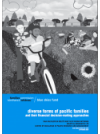Understanding Pacific peoples in the context of their families is crucial to working successfully with Pacific families and communities. During the past five years, the researchers have undertaken various research studies and community engagement projects which led them to believe that there is a need for better understanding of the nature of Pacific families in New Zealand and their decision-making processes.
These studies included The Needs of Pacific Peoples When They are Victims of Crime (Koloto 2003), Pacific Peoples’ Access to ACC Services and Entitlements (Koloto 2005), Pasifika Women’s Economic Well-being: Final Report (Koloto & Sharma 2005), Northland Pacific Health Survey (Koloto, Katoanga & Singsam 2006), Pacific Cultural Awareness Training Package (Koloto 2006) and the Pacific Living Standards Study Methodology Report (Koloto & Katoanga 2005).
The Pacific Living Standards Study (PLSS) is part of the Ministry of Social Development’s (MSD) ongoing research programme focusing on developing a comprehensive understanding of the living standards of New Zealanders. In May 2004 Koloto & Associates Ltd, a Pacific research company, was contracted by the Health Research Council of New Zealand (HRC) to carry out the PLSS, as part of its partnership programme with the MSD.
The key objectives of the PLSS were to:
- describe the current living standards of Pacific peoples
- gain a greater understanding of the reasons for the variations in living standards among Pacific peoples
- compare the different variations in the living standards of Pacific peoples with other population groups in New Zealand (Koloto & Katoanga 2005).
The PLSS was designed to complement the 2004 National Survey of the Living Standards of New Zealanders, the second national survey of the living standards of New Zealanders. This National Survey was commissioned by the MSD and was undertaken in 2004 by TNS New Zealand, a consultative market research company (Jensen et al. 2006).
Information and data for the PLSS were collected through face-to-face personal interviews with 520 family groups (FG) by a team of 26 Pacific researchers (which included Samoan, Cook Islander, Tongan,Niuean, Tokelauan and Fijian researchers).
The 520 FGs came from 268 Pacific households that were randomly selected from different meshblocks in Auckland, Christchurch, Hamilton, Tokoroa and the Wellington regions. The dataset for PLSS included much information about Pacific families.
Concerns about the need to better understand Pacific families in New Zealand led to the application for the Families Commission’s Blue Skies funding to undertake this study, which is an analysis of the data from the household spokesperson questionnaire.
This report was produced for the Families Commission Blue Skies Fund by Ana Hau'alofa'ia Koloto and 'Alisi Numia Katoanga.
Purpose
The study aims to answer the following research questions:
- What are the diverse forms of families in the Pacific households?
- What are the diverse forms of families by ethnic groups and locations?
- How do particular forms of families make financial spending decisions?
- Based on these findings on the nature and forms of Pacific families, what are the implications for policy and research involving Pacific peoples?
Methodology
Three questionnaires were used for the Pacific Living Standards Study. These included:
- a household spokesperson questionnaire, which was completed by a spokesperson in the household. A household spokesperson did not always mean the head of the household.
- a single family group questionnaire
- a couple family group questionnaire.
Questions that were relevant to the household were taken from the questionnaires used for the 2004 Survey of the Living Standards of New Zealanders, and incorporated into the household spokesperson questionnaire. New sections on household family group mapping and financial decision-making processes were added to the household spokesperson questionnaire.
In each household, a person was chosen by the family to be interviewed as a spokesperson on behalf of everyone in that household. In general, the researcher asked the person who answered the door to identify the appropriate member of the family who could speak on behalf of the household. This person was typically either the mother or father, or an adult daughter or son who was an English speaker. The spokesperson questionnaire identified the number of the family.
groups within that household. This ranged from one FG to seven FGs and may include a combination of couple family groups and single family groups. The researchers attempted to interview all FGs within each household. This was the major point of difference between the PLSS and the 2004 Survey of the Living Standards of New Zealanders. Whereas the 2004 survey interviewed one randomly-selected FG from each of the randomly selected households, the PLSS sought to interview all FGs within the randomly-selected households. This was aimed to address the researchers’ concern about the use of information from one FG to represent the Pacific households that may consist of more than one FG.

